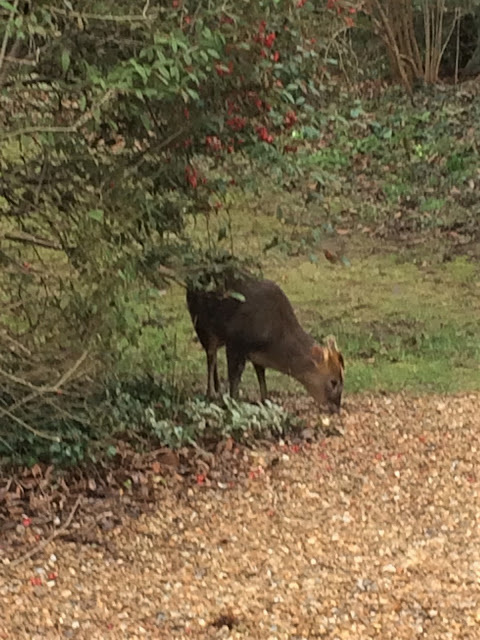January 2021
Amphibians and Reptiles
Gaynor Farrant has kindly agreed to become the new ANW Recorder for these
species. Please email her any sightings, particularly as they start to emerge
from hibernation over the coming months.
Birds
A total of 872 sightings,
including 44 different species were received this month – a number boosted by
the RSPB Big Garden Bird Watch which took place during the last weekend of the
month.
RSPB BGBW – an impressive
total of 22 reports were received, spotting 30 different species.
Fieldfare – 10
reports, mostly of 1-4 birds on the ORC and LSA, but also a flock of c30 on Perse
sports fields. Redwing – flocks of 10-30 seen in hedgerows right across
the villages, including GP, ORC, LSA, Abington Woods and Cambridge Rd - a
notable increase in sightings, with 19 reports mostly from in second half of
the month.
Common Gull – small numbers
spotted amongst larger flocks of Black-headed Gull (50-200), on GP cricket
field and Perse sports fields, and following the plough in fields along Bourn
Bridge Road.
Song Thrush – after an
apparent absence of some months, 17 reports of birds singing, and feeding in gardens
and on the LSA and ORC. Wren – a
few reports of 1-2 birds, similarly being seen and heard again in gardens this
month.
Reed Bunting – unusually,
seen again under feeders in one particular garden in Lewis Crescent, as was
the case at the same time last year.
Blackcap – a pair seen
on several occasions taking seed from feeders in Lewis Crescent, and a male on
the ORC.
Skylark – several reports
of up to 20, singing and displaying in loose flocks near AbPkFm. Meadow Pipit – flock of 11 feeding in
fields adjacent to Tom’s Wood. Pied Wagtail – flock of 12 feeding on GP cricket
field.
Goldfinch – reports
of good numbers (up to 23) at some feeders, alongside 4-8 Greenfinch and
2-6 Chaffinch, both seen more regularly this month. Blue Tit and Great
Tit also reported widely, and Long-tailed Tit more occasionally. A single Coal Tit and Goldcrest
continue to be seen occasionally in a Cambridge Road garden.
Dunnock and Robin
– 1-2 regularly in gardens, with both species occasionally heard singing.
Collared Dove – groups of
2-6, but up to 14, commonly seen under bird feeders, as were increasing numbers
of Stock Dove (4-6). Both Magpie (1-2) and Jay (1-3)
being reported more frequently around garden feeders at several locations.
Great Spotted
Woodpecker
– 1-2, both male and female, seen most days at some feeders, and a few reports
of Green Woodpecker, mostly in the fields adjacent to Church Lane.
Barnacle Goose – several
reports of 4-6 feeding on GP cricket field, and flying over Sluice Wood. Grey
Heron – 2 feeding in the flooded meadows between the churches. Mallard and Moorhen – also seen
on the flooded river meadows, as well as along the river and on GP lake.
Kestrel, Sparrowhawk
and Buzzard – 1-2 seen at several locations around the villages. Red
Kite – three reports of a single bird over both the LSA and Bourn Bridge
Road.
Butterflies,
Bees and other insects
Two reports, both at the end of the month.
a Harlequin Ladybird - in a house.
a Seven-spot Ladybird - on a shrub in garden.
Mammals
Fox – four spotted in
Granta Park on 15th, one along the ORC on the 17th, and one in Cook’s Field on
28th.
Muntjac – one in
Sluice Wood on 24th, one in Cambridge Road on 28th, and three on ORC on 31st.
Flora & Fungi
Aconite and Snowdrop in flower at several sites including Sluice Wood.
Rivercare
No organised activities in the river or litter-pick as all suspended due
to lockdown. The team however, continue to work individually. There was
a fair amount of flooding (the worst for several years), with some individual
efforts from the team to clear trees and debris arriving by river.
Two of the team attended an online discussion about an EU initiative
quantifying plastic waste pollution, carried by rivers to the ocean. The Great
Ouse is the largest and most northern catchment being studied, and the only one
not flowing directly into the English Channel. An attendee from
Linton reported some quite bad littering there, and since we see less downstream
in Abington, they seem to do a good job!
Weather
The rainfall in January totalled 83.5 mm, with the lowest recorded
temperature being minus 4.7 C on the 25th and the highest 14.5 C on the 28th. However,
we had several cold snaps during the month, so overall a more ‘normal’ January.
One really windy spell during the 3rd week, but otherwise fairly calm.
Many thanks to all those who contributed
reports of their sightings for January 2021:
Barry
Brooks, Peter Brunning, David Farrant, Gaynor Farrant, Jennifer Hirsh, Andy
Merryweather, Gill Smith, Maggie Turner, Derek Turnidge, Sally Turnidge – and all
those reporting in the BGBW.
Please email your sightings, within the
Abington parishes, to the relevant ANW Recorder:
Amphibians &
Reptiles Gaynor Farrant gaynorfarrant198@btinternet.com
Birds: Derek Turnidge derek@turnidges.com
Butterflies, Bees etc: Jennifer
Hirsh jennifer@hirsh.com
Mammals: Gill
Smith richardandgill.smith@live.co.uk
Flora recorder currently vacant - if interested, please
contact David Farrant for more details.
Abbreviations:
GA – Great Abington, LA – Little Abington, LSA – Land Settlement Association,
GP – Granta Park, ORC – Old Railway Cutting. AbPkFm – Abington Park Farm.































